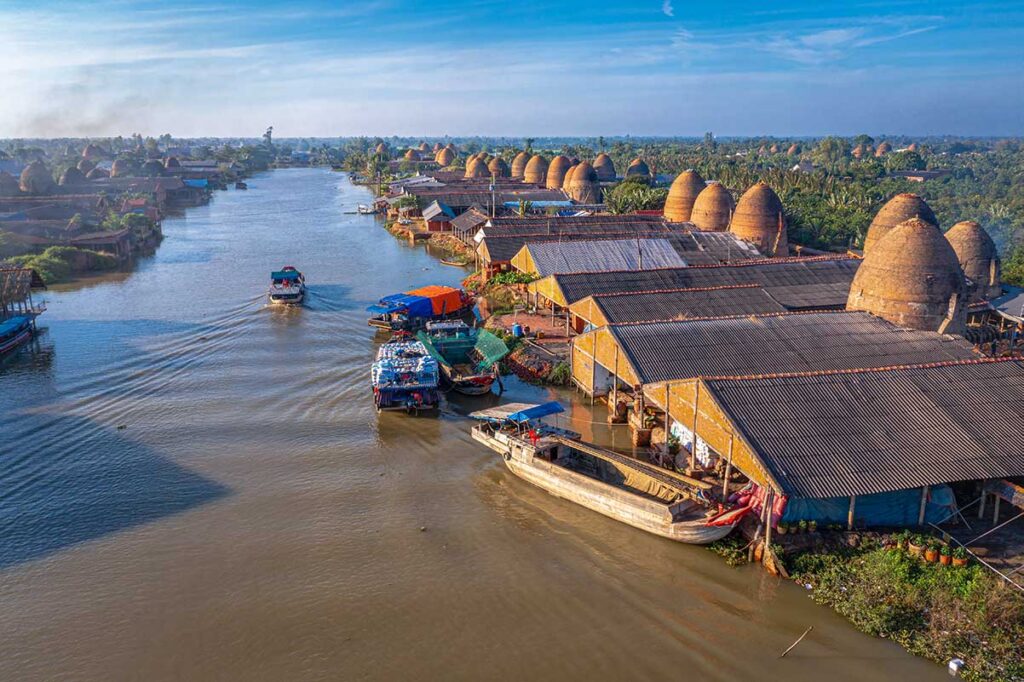What are the workshops, factories and kilns of Vinh Long?
When you travel along the Co Chien and Mang Thit rivers, you’ll notice clusters of tall, round kilns that look a bit like red-brick castles. These are the traditional brick and pottery kilns that once made Vinh Long one of the most important production centers in the Mekong Delta.

The area is often described in two ways: some call it a brick village, others a pottery village. In reality, both are true. The same clay deposits from the riverbanks were used to make red construction bricks as well as terracotta household items and garden pottery. The workshops that remain today are usually small, family-run operations, and many kilns are no longer active but still stand as part of the riverside landscape.
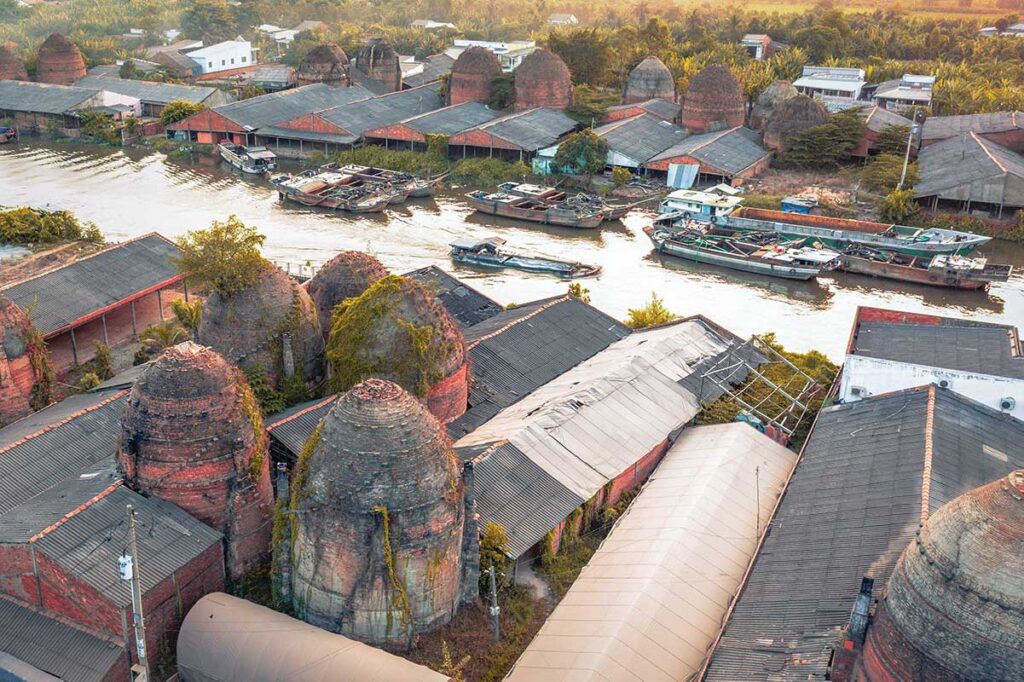
For visitors, this means you’ll see a mix: abandoned kilns covered in moss, quiet factory yards, and the occasional workshop where craftsmen are still firing pottery. It’s less of a single “village” you can walk through and more of a scattered craft zone stretching for kilometers along the river.
A brief history of the kilns
Origins and growth
The first kilns in Mang Thit were built in the late 19th century, with records pointing to around 1887 as the starting point. The Mekong’s alluvial soil created rich clay deposits, perfect for brick and terracotta production. With rivers acting as natural transport routes, the area quickly developed into one of southern Vietnam’s main craft zones for construction materials.
The Kingdom of Bricks (1990s heyday)
By the 1990s, Mang Thit had reached its peak. More than 1,500 kilns were active in the district, producing millions of red bricks and roof tiles each year. Their durability and color made them famous across Vietnam and even exported to countries like Thailand, Cambodia, and Malaysia. This success earned the region its nickname as the “Kingdom of Bricks”, later also celebrated as the “Kingdom of Red Pottery.”
Decline and present situation
The turn of the century brought major change. Modern factories and stricter environmental rules gradually pushed traditional kilns out of business. Many have since been abandoned, their conical shapes now standing like silent red castles along the riverbanks. A smaller number of workshops continue to operate, focusing more on terracotta pottery such as planters, garden décor, and tiles. These surviving businesses keep the tradition alive, though the scale is far smaller than in the past.
The kilns today
What you see today in Mang Thit is less a busy craft village and more a mix of industrial heritage and cultural landscape. Along the riverbanks stand hundreds of mushroom-shaped kilns, their red brick walls often faded, cracked, or covered in moss. From a distance, they can look like clusters of ancient castles rising out of the flat Mekong scenery.
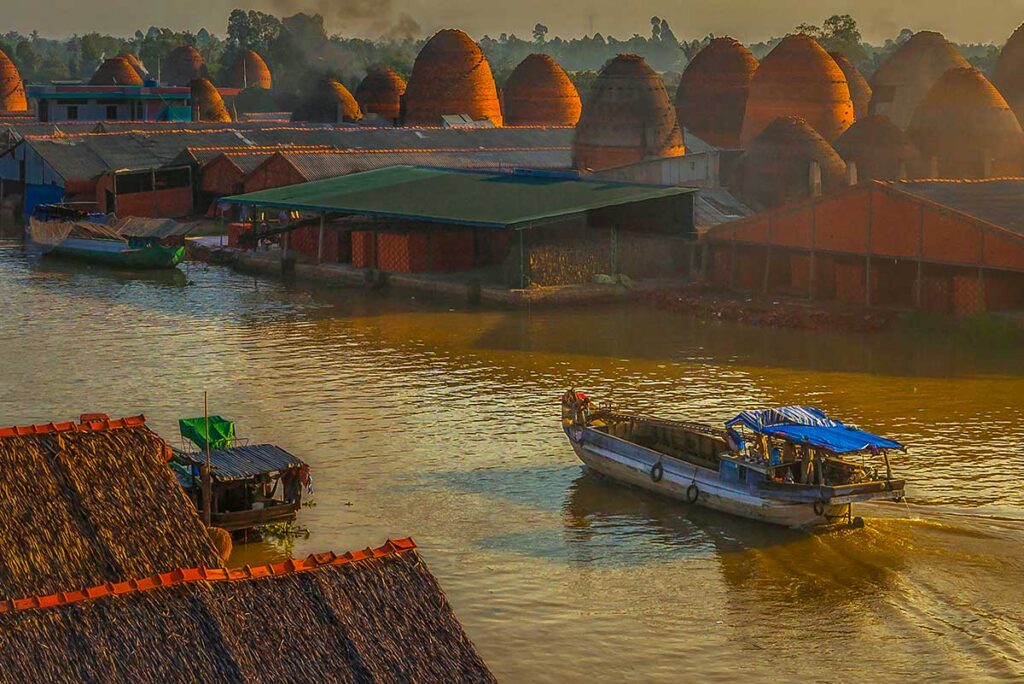
A handful of kilns are still in use, and with luck you might spot one firing, with smoke drifting out of the chimney and workers tending the flames. Most, however, are abandoned and silent, their doors sealed shut. This gives the area a slightly surreal atmosphere: half-working craft zone, half-ruined monument.
For travelers, it’s important to know this is not a polished tourist attraction. There are no tickets, no visitor centers, and little in the way of services. What makes it worthwhile is the visual impact and the chance to explore a disappearing tradition up close. If you enjoy photography, local culture, or unusual off-the-beaten-path sites, the Mang Thit kilns are memorable — just don’t expect a curated experience.
Where are the kilns located in Vinh Long?
The kilns are spread out over a wide area, stretching for nearly 30 kilometers along the Co Chien and Mang Thit rivers. The heart of the craft zone lies in Mang Thit District, especially in communes like Nhon Phu and My An, though parts of neighboring Long Ho District also have clusters of kilns.
They’re easy to spot from the water: tall, conical red-brick structures standing side by side, often compared to small castles. From the river, the sight of dozens of chimneys lining the banks is one of the most striking views in the Mekong Delta.
You can reach the area in two main ways. By boat, departing from Vinh Long City or on a larger Mekong tour, you’ll get the best perspective as you glide past the riverside kilns. By road, you can follow highways DT907 and DT902, which run parallel to the rivers and give access to some of the most photogenic stretches, especially at sunset.
What you can see & Learn (The Process)
1. Clay digging & transport
Along the river you’ll find clay pits where material was once dug by hand and hauled in baskets; today it’s mostly excavators and conveyor belts. The clay is mixed with sand in ratios set by each workshop, then moved by boat straight to riverside factories — one reason the kilns cluster along the banks.
2. Shaping bricks and pottery
For bricks and tiles, the clay is pressed into molds by machine and stacked to dry. For pottery, workshops often use gypsum molds to cast planters, jars, and cookware. Pieces are trimmed and smoothed by hand — a quick, practiced routine you can sometimes watch up close if the workshop is open to visitors.
3. Drying
Fresh pieces dry in the sun for 3–7 days (longer in the wet season). As moisture leaves, the surface shifts from dark grey to a muted red — that characteristic Vinh Long tone. Expect simple drying yards, not a showroom: wind, dust, and sudden rain are part of the job here.
4. Loading & firing in the kilns
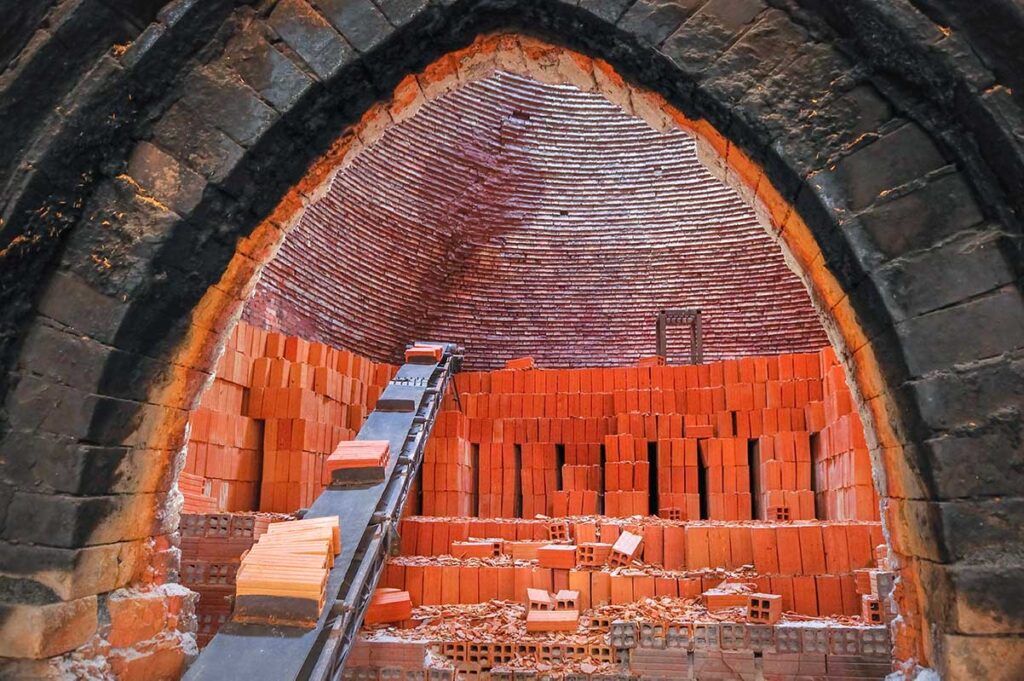
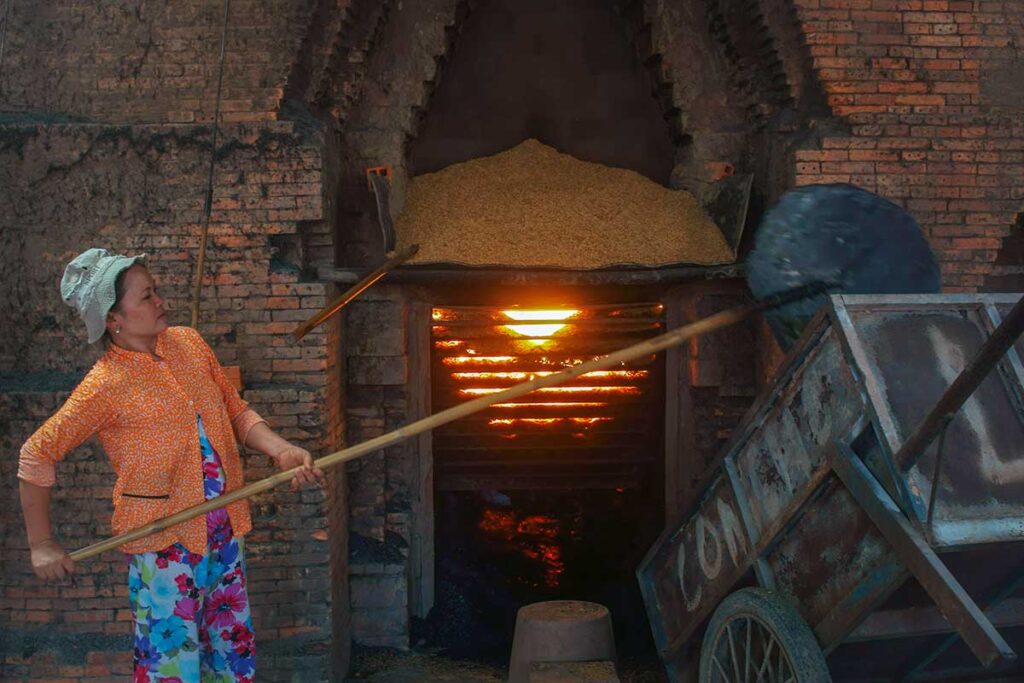
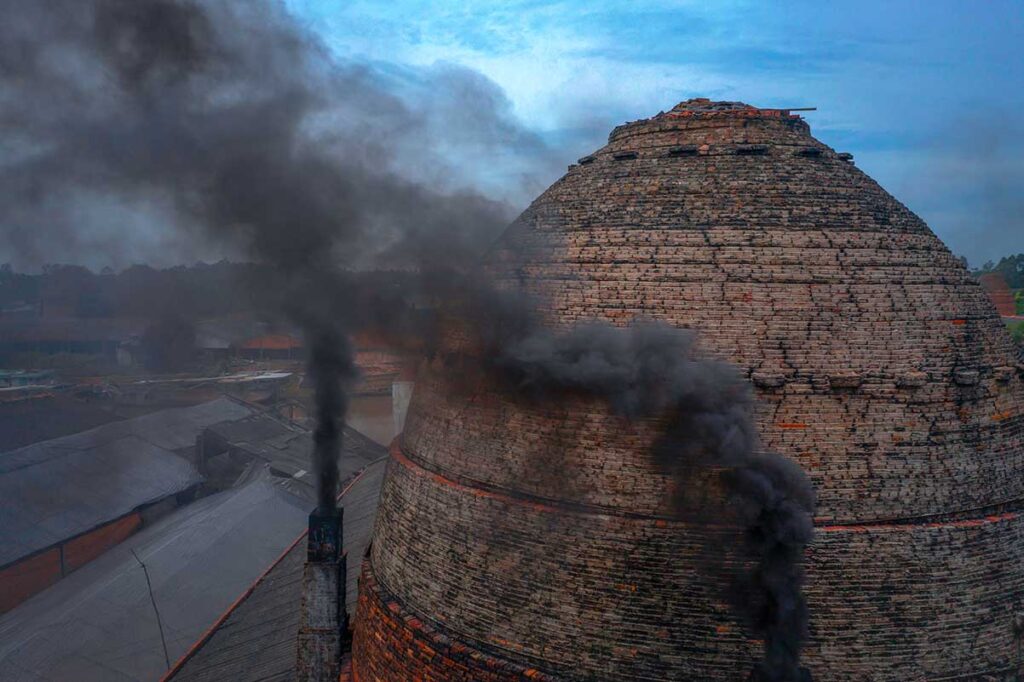
The conical brick kilns reach up to ~12 m high. Workers stack the chamber carefully so heat spreads evenly, then seal the opening and fire with rice husks. A firing cycle typically lasts 7–15 days, reaching around 900°C at peak. You may notice small altars at kiln entrances — offerings to the “kiln god,” a local tradition among craftsmen.
5. Cooling & transport
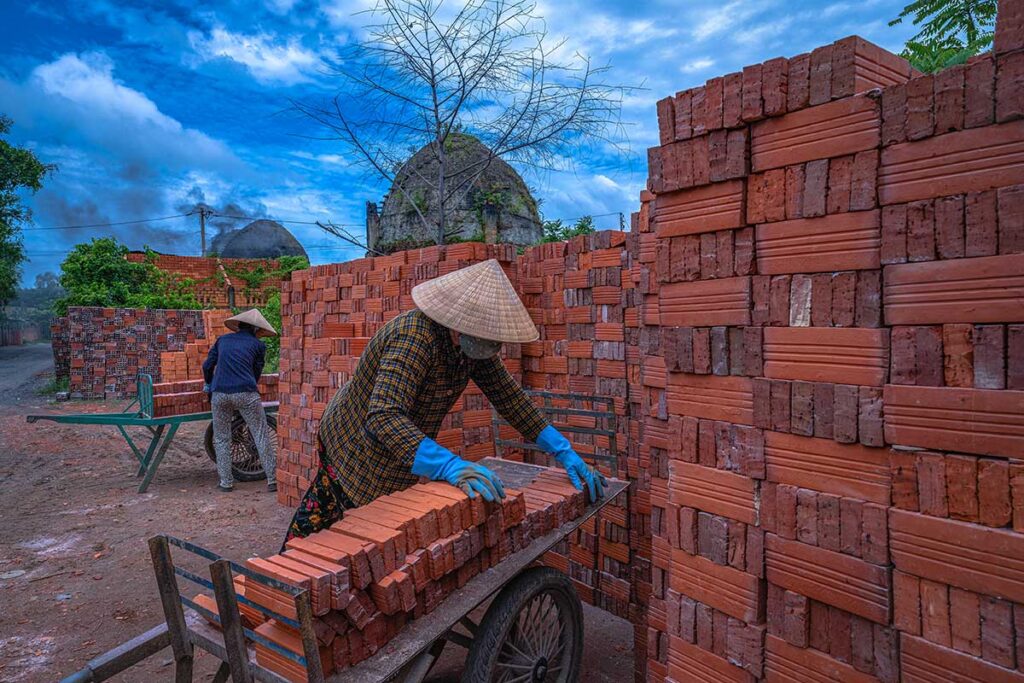
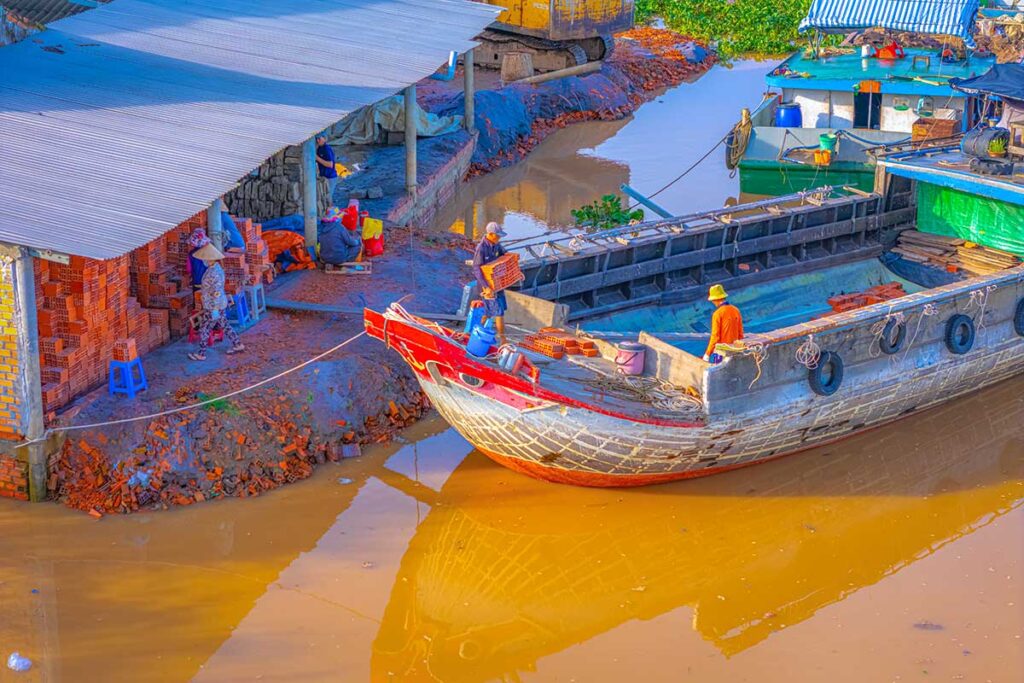
After firing, the kiln is sealed to cool before unloading. Finished bricks or pots are carried out, sorted, and packed. From here, boats still do much of the heavy lifting, taking loads along the Co Chien and Mang Thit rivers to buyers across the Delta — the same river network that helped this craft grow in the first place.
How to visit the Kilns of Vinh Long
Best ways to see them
The most atmospheric way to experience the kilns is by boat, gliding past long stretches of chimneys rising above the riverbanks. From the water, you get a real sense of scale and can imagine how busy the area once was. If you prefer to travel overland, following DT907 and DT902 gives access to some of the most photogenic kiln clusters. Late afternoon is especially rewarding, with the red brick glowing in the low sun.
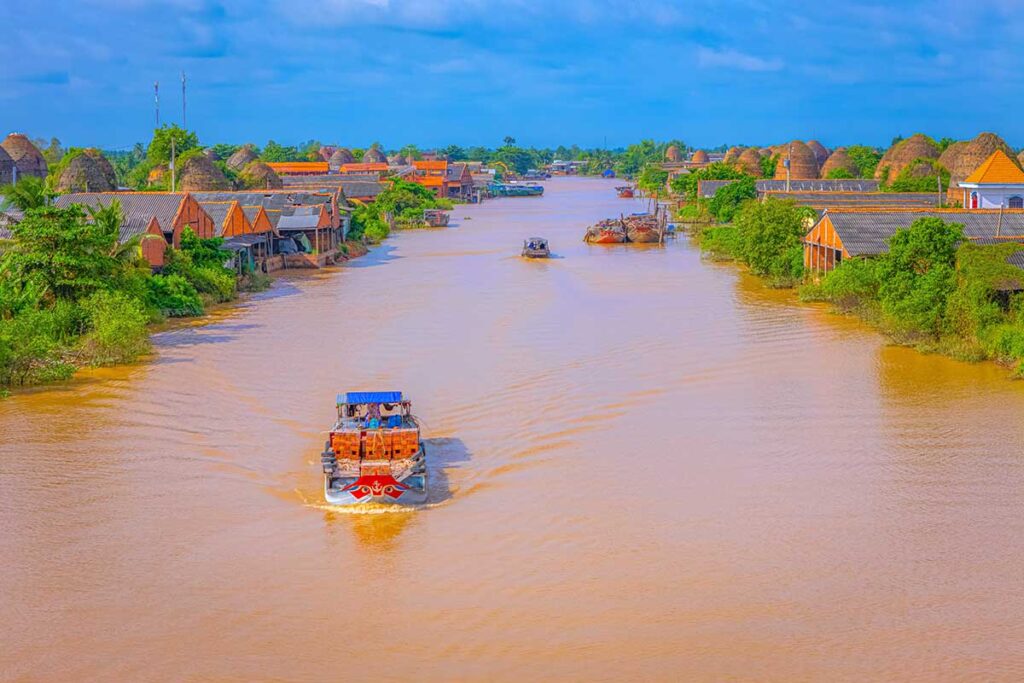
Access & tours
While you can drive or cycle past the kilns on your own, access inside workshops is limited. Only a few allow walk-ins, and communication can be a barrier. The best way to get a closer look is through a local guide or by staying at Mekong Pottery Homestay, which organizes insider tours and introductions to families still working in the craft. Without local help, you may find it difficult to go beyond taking photos from the roadside or riverbank.
What to expect as a visitor
It’s important to set expectations: this is not a formal tourist site. There are no entry tickets, no museums, and very little signage. What you’ll find are abandoned kilns you can sometimes walk around, and in lucky cases, a working yard where you can watch craftsmen at work. The draw is the atmosphere, photography opportunities, and sense of history — not polished visitor facilities. For travelers interested in culture and offbeat places, it can be a highlight; for others, it may feel more like a short stop than a full excursion.
Travel tips for visiting Mang Thit Kilns
- Timing: Aim for the late afternoon when the red brick structures catch the warm glow of the sunset. This is the best time for photography and also when the heat of the day has eased.
- Footwear: Paths around the kilns can be muddy and uneven, especially after rain. Sturdy shoes or sandals with grip are more practical than flip-flops.
- Heat & dust: Bring water, a hat, and be prepared for a mix of dust and soot. If you happen to pass an active kiln, the air can be smoky.
- Respect: Many workshops are family-run. Always ask before entering, and don’t assume every site is open to visitors. A smile and a gesture go a long way.
- Photography: The kilns are highly photogenic, but remember people are working here. Be discreet with your camera and avoid interrupting craftsmen while they work.
Is Mang Thit worth visiting?
Mang Thit offers one of the most unusual sights in the Mekong Delta — a riverside landscape dotted with hundreds of conical kilns that feel more like ancient ruins than working factories. For travelers interested in photography, history, or exploring places that are firmly off the tourist trail, it can be a rewarding stop.
That said, this is not a polished attraction. Many kilns are abandoned, services are minimal, and without a guide it can be difficult to get more than a surface-level impression. For most visitors, the kilns are best enjoyed as part of a broader Mekong Delta trip, combined with a boat tour around Vinh Long or other nearby destinations.
